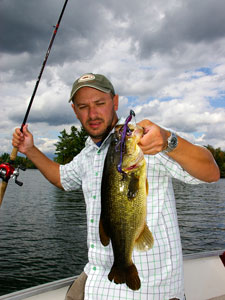
Fishing stained water comes with its own set of rules. Adapting to the conditions, by knowing what plastic body shapes, sounds, and colors work best, will help put more fish in the boat.
Plastic Bait Body Shape
 |
| Fishing lure color is critical to success with soft plastics, so consider bright hues. |
Plastic baits come in a large assortment of shapes. When faced with a lack of water clarity, however, some are more effective than others.
Choose baits that present a large profile. This will allow fish to key-in on them much easier by creating a larger silhouette. In comparison to fishing in clear water, I like to upsize my baits by at least 20 percent.
Sounds the Baits Can Make
Sound also comes into play, and baits that give off increased vibrations get the nod. This could be a paddle tail worm — with a loud "thumping" action — curly tail grub or baits with multiple appendages.
Ribbed soft plastics are also a great choice, as water "bubbles" get trapped and released during movement in the water.
Fish will rely on their lateral line more when sight is diminished, meaning the greater the sound frequency or vibration your lure can produce, the better the chance that a fish will be able to find it.
Baits that give off little to no sound are still effective, but your odds will increase if you can give the fish some noise underwater.
For an added advantage, worm rattles inserted into the body of your bait can help turn the sound volume up. Always good to keep these on hand for those times you are faced with dirty water.
The Fishing Lure Color Game
The lure color you choose can be critical to your success on the water. When fishing slightly stained lakes or rivers, bright hues — such as red, orange and chartreuse — will work to your advantage. For muddy or overly stained water, relying on dark colors such as black or brown will bring the best results. The silhouette principal comes into play here, as when light cannot penetrate the water column, colored lures are rendered basic shades of black or grey — far from what they appear above water.
Another useful tip is to toss two-toned plastics. Contrasting colors will give the fish a second option in terms of visibility and can enhance the likelihood that your lure will be seen.
Experimentation is often key when trying to figure out a stained water pattern. Keep shape, sound and color in mind the next time you are faced with less than ideal water conditions. It will help put more fish in the fishing net.
- 16631 views

